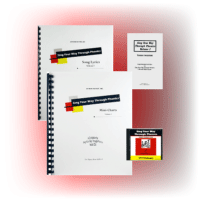





Lower-case Letter Recognition Lesson Plan
Little Partners
- Students will learn to recognize the lower-case letters of the alphabet when seeing the letters in print.
- Students will learn how to write the lower-case letters of the alphabet with the help of musical rhymes.
There is a reason why kindergarten and pre-school students recognize capital letters more easily than lower-case letters. It is because, unlike the capitals, lower-case letters often look very similar to each other. The lower-case alphabet letters are composed of only a limited number of basic shapes which we can label as the hole (circle), the stick (short line), the pole (long line), the curl (partial circle), the hump (gumdrop shape), and the curly pole (pole plus curl). Examples: Letter d is a hole and a pole, while letter b is a pole and a hole. Notice that we describe the letters from left to right, in the same direction that we read and write. In this lesson plan, the song Little Partners addresses the issue of lower-case letter recognition by teaching the set of basic shapes. With this vocabulary, both students and teacher are able to describe the lower-case letters, taking them out of the realm of the abstract. It should be noted that some lower-case letters very closely mimic their capital letter partners. Examples: Cc, Kk, Oo. Because students do not have difficulty identifying these letters, they are not included in the song. Every time students sing the song Little Partners, they reinforce lowercase letter recognition by pointing to letters and tracing them with their fingers in the corresponding Mini-Charts. With daily practice, students can learn to recognize and write the entire lower-case letter alphabet within a few weeks. Once the basic song is learned and students can sing alone with the CD’s instrumental track, they are ready to learn how to link letters and sounds with the song, What’s That Sound?. Before teaching this lesson, be sure that students have learned the capital letters as covered in the previous lesson, Recognizing Capital Letters. The capital and lower-case letters can also be reinforced with the Read-and-Sing books, Alphabet Letters and Little Partners. Note that this song teaches the manuscript printing forms of letters a and g, since these are used in early writing and since many of the students’s early reading books use these fonts. However, commercial print often contains the letters a and g that look different from the way these letters are printed by children. It is important to call attention to these differences for students, as well as the differences in D’Nealian handwriting.
- Sing Your Way Through Phonics Volume 1 CD, Tracks 3 and 4 (Listen to audio sample)
- Sing Your Way Through Phonics Volume 1 Mini-Charts (pp. 16-23)
- Cards with capital and lower-case letter sets (see below)
- Optional: Plastic letters, sock or small bag, clay or modeling dough, laminated cards with headline, midline, and baseline (see below)
Note: If you do not have the CD or Mini-Charts, you can still teach this lower-case letters lesson plan using the folk tune listed on the Little Partners Song Lyrics page. You can create your own mini-charts using the words in bold print letters in each verse of the Song Lyrics.
View our Read-and-Sing book, Little Partners, that coordinates with this lesson.
Find out more about Sing Your Way Through Phonics products.
Order our cost-saving Volume 1 Combo online.
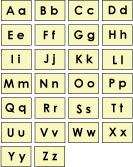




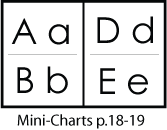

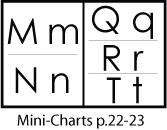
- Hold up two letter-set cards (ex: Ee and Cc) and say,“On each of these cards, we see a capital letter and a small letter. Which one shows a small letter that looks a lot like its capital partner letter?”(Cc) “Which one shows a small letter that looks quite different from its capital partner letter?”(Ee)
- Say,“Now, let’s look at the rest of the alphabet and find all the cards where the capital and small letters look a lot like each other. If you get a card where capital and small letters look almost the same, put it in this pile where I’m putting the card Cc. If you get a card where capital and small letters look quite different, put your card in the pile where I’m putting the card Ee.” Distribute cards and allow students to place them in the appropriate piles. When done, hold up each card and ask the class to confirm whether the capital/lower-case letter sets are alike or different. (Alike: Cc, Li, Jj, Kk, Oo, Pp, Ss, Uu, Vv, Ww, Xx, Yy, Zz; Different: Aa, Bb, Dd, Ee, Ff, Gg, Hh, Ll, Mm, Nn, Pp, Qq, Rr, Tt.
- Point to Sing Your Way Through Phonics Vol. 1 Mini-Charts pp. 16-17, and say “These are the shapes that we use to make the small letters. Small letters are also called lower-case letters.” Point to the charts and say, “A long line is a pole; a circle is a hole, a short line is a stick, a curvy line is a curl, a pole and a curl together is a curly pole, and a gumdrop [or mound] shape is a hump.” Point to each picture and ask students to identify them. Give help, if needed.
- Say, “Now let’s look at the small letters that look different from their partners and see if we can tell what shapes are used.” Hold up the card with Aa. Say, “What shapes are used for small a?” (a hole and a stick) Go through the rest of the pile and help students describe the shapes used for each lower-case letter. Examples: b = a pole and a hole, d = a hole and a pole, e = a curl and a stick, f = a curly pole and a stick, g = a hole and a curly pole, h = a pole and a hump, l = a pole, m = a stick and two humps, n = a stick and a hump, q = a hole and a pole, r = a stick and a curl, t =a pole and a stick.
- Turn to Mini-Charts on pages 18-19 and say, “Let’s listen to a song that tells about the shapes of small letters that don’t look like their partners. This song is called, Little Partners.” Play Sing Your Way Through Phonics Vol. 1 CD Track 3 and point to the Mini-Charts on pp. 18-23 each time a letter is described.
- Say, “Let’s play the song again and see if you can join in on the repeated parts.” Play CD Track 3 again. Students should be able to join in on the lines, “Capital __ has a partner, but the two don’t look the same.” and “Yet they both have the very same name.” Also, “I can match up big and small.” and “Some capital letters have partners who don’t look like them at all.” [Consult Little Partners Song Lyrics, if needed.]
- Review the shapes of the lower-case letters on Mini-Charts pp. 18-23, naming the component shapes, as before.


- Practice singing Little Partners daily for a few weeks. Allow some of the students be the leaders, tracing the letters and and pointing to the Mini-Chart pages with their fingers as they sing. For every set of facing pages, choose 1-2 students to be the tracing and pointing leaders.
- Check how well students know the words to the song by singing with the instrumental version (Track 4). Continue pointing and tracing on the Mini-Charts to serve as visual cues linking the words of the song to pint.
- Using the Mini-Chart Templates to change the order of letters in the song. For example, replace Aa and Bb on the page 18 of the Mini-Charts with Ff and Tt. Sing, “Oh capital F has a partner but the two don’t look the same. Small f is a curly pole and a stick, but they both have the very same name. And capital T has a partner who doesn’t look like him at all. Small t is a pole with a stick right through. I can match up big and small.”

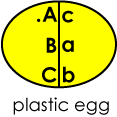


- Introduce the Read-and-Sing Book, Little Partners. Help students trace the shapes of the letters hidden in the book’s illustrations. Keep a few copies of the book at a literacy center equipped with headsets so that students can gain practice in listening, singing, and tracing the lower-case letters.
- Use plastic eggs to create a manipulative for capital/lower-case matching. On the left side, print 5 letters in order. On the right side, print the lower-case partners, out of order. Place a dot on the first capital letter for each egg. To create eggs for the whole alphabet, you will need 5 eggs. Print six capitals and their partners on the last egg. Students rotate the right half of the egg until the matching partners line up. Then then rotate the entire egg so that they are focusing on the second capital letter. Again, the right half is rotated until the partner letter lines up. Continue this way until the letter with the dot is reached again. Then replace the egg (in an egg carton) and move on to the next egg in the series. Hints: Use black Sharpie markers to print the letters. Cover printing with clear-drying glue so print will not rub off over time. Grease rotating surfaces with crayon for ease of movement.
- Create laminated template cards with one lower-case letter printed on headline, midline, and baseline. Have the students form long snakes out of clay. First they place their “snakes” over the template letter. In the adjacent space, they can form the letter without using the template.
- Play What’s in the Bag? Place 2-3 pairs capital and lower-case of plastic letters in a small brown bag or sock. Activity 1: The first student picks a letter. The second student must choose the partner letter by feel alone. Activity 2: Name a letter and ask the student to withdraw that letter without looking. Activity 3: The student places his/her hand in the bag and finds one letter. S/he tries to identify it and then withdraws the letter to check. This is a good game to be played with partners at learning centers.
- Create lower-case letters in shaving cream, pudding, wet sand, wet eraser on chalkboard, finger paint on trays, finger paint in plastic-lock bags.
- Students correctly identify all the letters on Mini-Charts pp.18-23 in random order
- Students print all the lower-case letters or create the letters with other media such as clay, finger paints, or wet sand.
